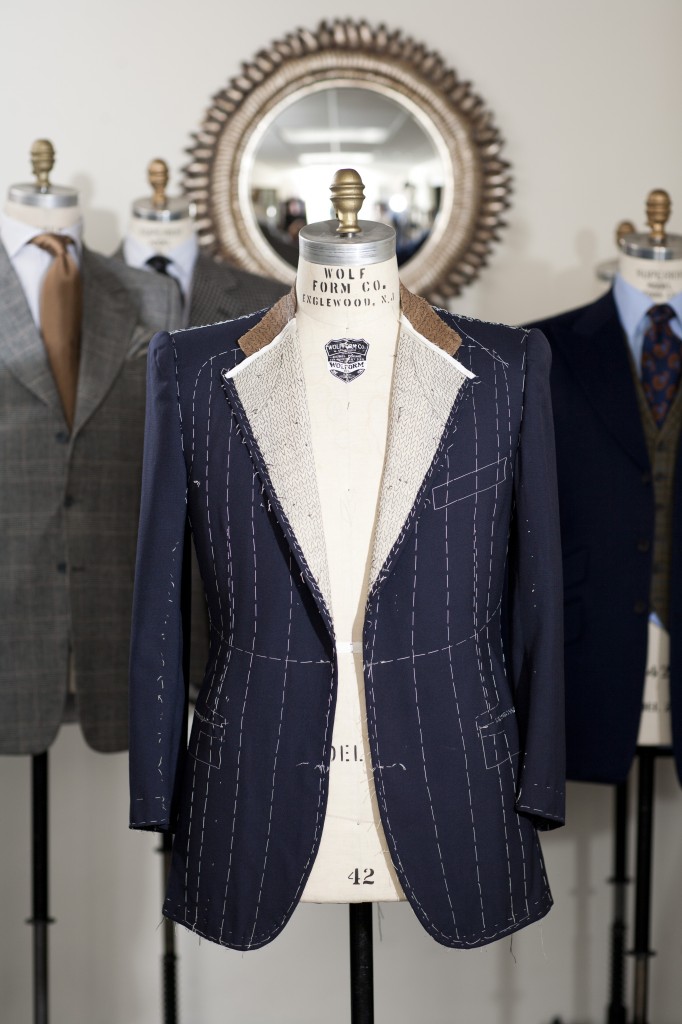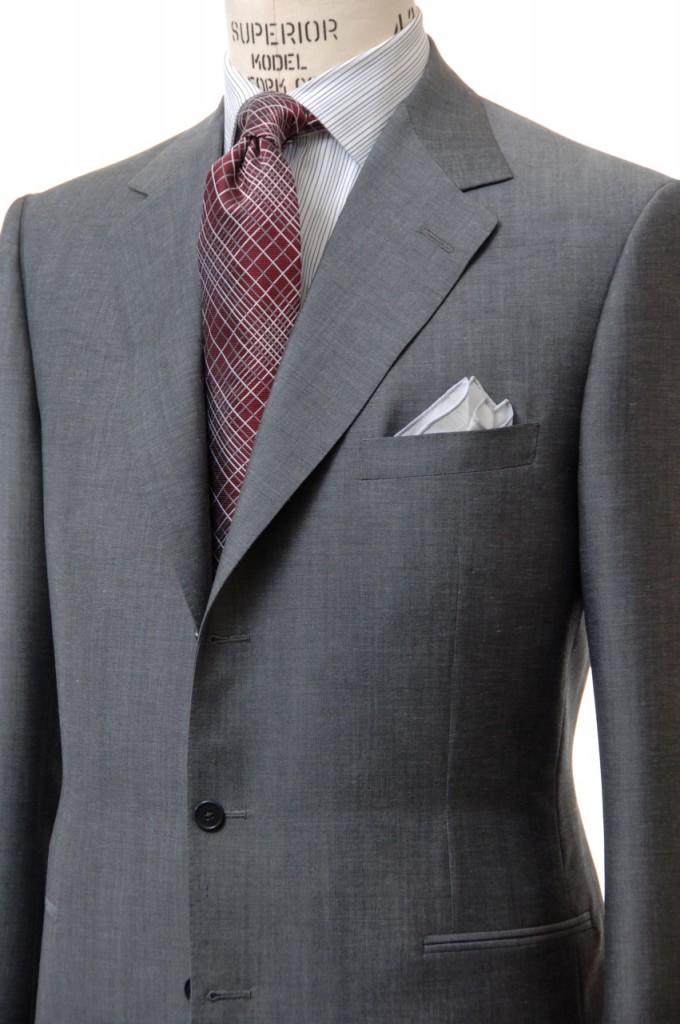Jon Green is a celebrated New York-based bespoke clothier well-known to readers of Forbes, The Financial Times, and American Express’ ‘Departures’ magazine. He is also a good friend of OTC and occasional contributor. Here, Jon provides us with a useful breakdown of the various forms that tailored clothing can take, from ready-made to bespoke.
Bespoke is a term that has been widely used in the United Kingdom for centuries, but has only recently been employed in the United States by tailors attempting to distinguish “bespoke” construction from “made-to-measure,” “custom,” and “bench,” terms often incorrectly used interchangeably. The word bespoke is derived from the English verb of the 17th century, “to bespeak,” i.e., “to speak for something, to give order for it to be made.”
As such, bespoke is actually a very specific and clearly defined term. However, it is also a word so unique and meaningful to the clothing space that marketers and retailers now use it to convey any form of personalization designed to instill a sense of special uniqueness.
The growing menswear market has been especially guilty of this tactic, calling virtually anything that can be customized in any way, bespoke. On the face of it, those who deal in the world of true bespoke will never be confused by this colorful marketing gambit. And, most of those who employ the term to differentiate or highlight their wares or product are often fully cognizant of their deception, mild though it may be.
Still, having a clear understanding of the terms and methods of construction ascribed to various types of clothing, how they are made, and the inherent quality and attention to detail associated with each, is invaluable.
Ready-Made
Ready-made clothing is cut from ‘graded’ commercial patterns. The process of grading was developed over 150 years ago with the advent of massed produced pattern-built clothing. As standardized sizing does not exist, all manufacturers/designers develop their own patterns and grade them. Grading systematically increases or decreases measurements in order to maintain consistent fit and styling throughout a range of sizes. The intent is that they will fit and look the same on everyone regardless of size, which means they fit no one particularly well.
Since most men hate to shop for their clothing, the task often falls to a significant woman, who sends the man, or drags him to the store or a neighborhood tailor for alterations. 70% of men’s tailored clothing sold in the United States is bought by women.
Often, women have a greater degree of confidence buying menswear made by a designer they like for their own clothing. Therefore, manufacturers consider it more important for their suits to look good on a mannequin and to have ‘hanger appeal’ than tackling the impossible task of trying to fit so many different body types and sizes with garments cut from graded commercial patterns. Once cut, the ready-made suit is assembled on a production line by machine operators trained in specialized piecework.
Made-to-Measure
Made-to-Measure clothing is cut and made in the same way as ready-made clothing with one exception: a ready-made pattern is adjusted during cutting for some of the fitting requirements of the customer. The garment is then assembled in the same way as ready-made by machine operators on the same production line. However, a few manufacturers report areas in their factories used exclusively for their made-to-measure production.
As the U.S. economy rapidly expanded after World War II through the 1960s, the growing demand of men seeking more specificity in their tailored clothing, and willingness to pay extra for it, persuaded men’s clothing manufacturers to offer made-to-measure clothing as an accommodation to the stores for whom they made ready-made clothing. Today, made-to-measure clothing is the fastest growing segment of men’s tailored clothing business.
Bespoke
 Bespoke clothing requires a much more extensive process. Bespoke clothing is a collaboration initiated with a conversation with the client to determine preferences of style, cloth, and the appropriateness of colors.
Bespoke clothing requires a much more extensive process. Bespoke clothing is a collaboration initiated with a conversation with the client to determine preferences of style, cloth, and the appropriateness of colors.
The construction of bespoke clothing begins with a master pattern maker and cutter hand-drafting and hand-cutting a paper pattern specific to the individual. This pattern will incorporate more than 30 measurements specific to the client.
The cloth and trimmings are then sponged – dampened and allowed to dry – which takes any shrinkage out of them in the even one gets caught in the rain or if a dry cleaner turns up the dryer to shorten drying time. Next, the cloth and the “canvas” are cut and assembled by hand with a needle and thread by a master tailor into a “first fitting” using basting stitches – temporary stitches that do not stress the cloth and are easily removed. After every fitting, the alterations to the garment are recorded on the paper pattern.
After alterations are made, the garment parts are reassembled for the “second fitting.” Following this process, there is usually one more fitting in a more advanced stage of completion.
The finished garment will be made with an abundance of hand tailoring by a single master tailor, a process requiring a minimum of 60 hours for the jacket alone. The paper pattern resulting from this process is kept for use in taking subsequent orders directly to a third fitting, or to finish.
Defining Bespoke
The question is often raised as to why the term bespoke is not more robustly protected. It may seem counterintuitive since the British invented bespoke construction, but while the distinction conferred by “bespoke” is protected by law in France, the British Advertising Standards Authority (ASA), the British advertising regulator, has ruled that it is a fair practice to use the term bespoke for products which do not fully incorporate traditional “bespoke” construction methods as described above.
 In June 2008, the ASA, ruled that an advertisement describing a suit, “put into a ‘working-frame’ where it would be cut and sewn by machine,” as a “bespoke suit uniquely made according to your personal measurements and specification” was not breaching the Authority’s self-proclaimed advertising codes, notably the truthfulness rule, because the use of the term bespoke was not deemed likely to confuse. This ruling was significant in formalizing a less traditional definition of bespoke clothing, even though the older distinction with made-to-measure was recognized.
In June 2008, the ASA, ruled that an advertisement describing a suit, “put into a ‘working-frame’ where it would be cut and sewn by machine,” as a “bespoke suit uniquely made according to your personal measurements and specification” was not breaching the Authority’s self-proclaimed advertising codes, notably the truthfulness rule, because the use of the term bespoke was not deemed likely to confuse. This ruling was significant in formalizing a less traditional definition of bespoke clothing, even though the older distinction with made-to-measure was recognized.
Notably, the ruling also cited the Oxford English Dictionary definition of bespoke as “made to order,” despite the fact a bespoke suit was “fully hand-made and the pattern cut from scratch, with an intermediary basted stage which involved a first fitting so that adjustments could be made to a half-made suit.” While a suit made-to-measure “would be cut, usually by computer, from an existing pattern, and adjusted according to some of the customer’s measurements,” the ASA stated that both fully bespoke and made-to-measure suits were ‘made to order’ in that they were made to the customer’s precise measurements.
Jon Green
Jon Green Bespoke
509 Madison Avenue
New York, NY 10022
212.861.9611
[email protected]


Great post Jon! I think many fail to appropriately distinguish between bespoke and made to measure particularly, failing to realise just how much intricacy is involved in bespoke in comparison.
This is a great explanation of going up the “sartorial ramp” as one bespoke aficionado explained it to me when I was doing research for my book, The Coat Route: Craft, Luxury & Obsession on the Trail of a $50,000 Coat.
It’s a shame that the word “bespoke” is being diluted–and used by all kinds of businesses that have nothing to do with custom clothing.
Meg – Thank you very much for your kind words. Judging by the reviews given to your book – Tim Gunn and Bill Bryson, no less – you know full well the value and quality inherent to genuine bespoke.
Good day I am so grateful I found your webpage, I really found you by
error, while I was looking on Yahoo for something else, Anyways I am here now and would just like to say thank you for a tremendous post and a all round interesting blog (I also love the theme/design), I don’t have time to read through it all at the moment but I
have book-marked it and also added your RSS feeds, so when I have time I will be back to read more,
Please do keep up the awesome work.
I enjoy what you guys are up too. This type of clever work and coverage!
Keep up the excellent works guys I’ve included you guys to
my blogroll.
Wow, superb blog structure! How long have you ever been blogging
for? you make running a blog glance easy. The whole look of your site is
excellent, let alone the content material!
What’s up everyone, it’s my first pay a quick visit at this web page,
and piece of writing is actually fruitful in favor of me, keep up posting such posts.
Many thanks for an North Face clearance sale excellent blog, The North Face storeI am going to frequently to find out. We are like the From Ready-Made to Bespoke | Off the Cuff art weblog really a lot,I absolutely give many thanks to the contributor for this kind of a From Ready-Made to Bespoke | Off the Cuff decent , I will retain coming to your internet site.i will be viewing this web-site again.
What a great article!